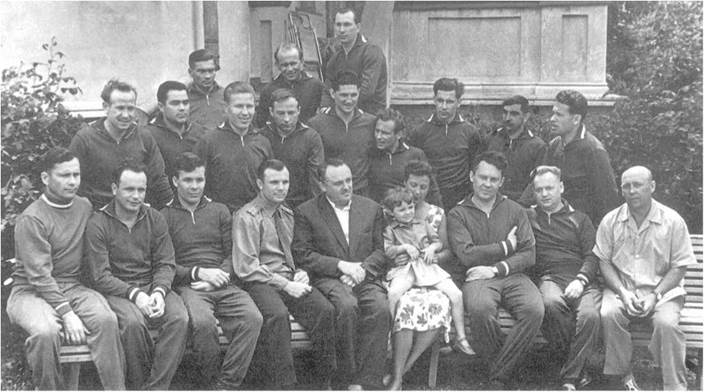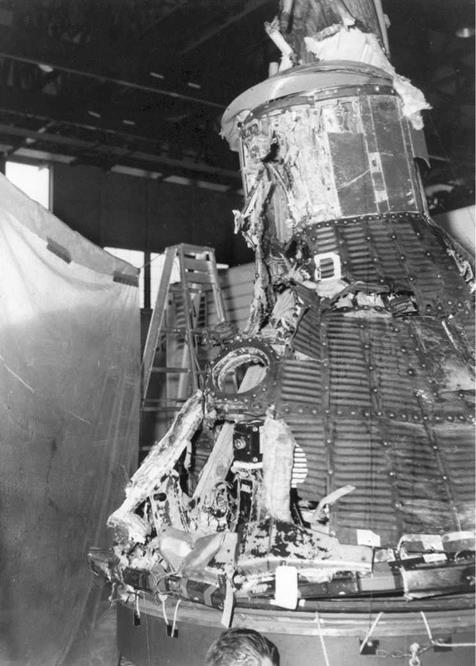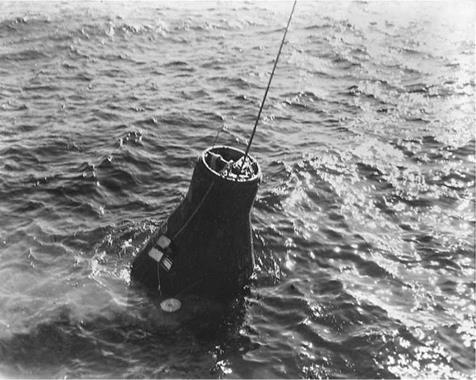HOTSHOT
Cooper almost missed out on flying in Project Mercury entirely. Since his selection in April 1959, he had steadily gained a reputation for himself, firstly as a hotshot pilot with a passion for fast cars, but also as a complainer who pulled dangerous stunts, including one in an F-106 jet which screamed right outside, and below, Walt Williams’ office window. Moreover, Deke Slayton wrote of his personal surprise that Cooper had been chosen as an astronaut at all. ‘‘My first reaction was, something’s wrong,’’ he noted. ‘‘Either he’s on the wrong list or I am. Gordo was an engineer at Edwards. As far as I was concerned, he wasn’t even a test pilot.’’
Test pilot or not, if Schirra had been flying before he was born, then Leroy Gordon Cooper Jr was all but born in a pilot’s seat. His father, an Air Force lawyer, county judge and pilot from Shawnee, Oklahoma, frequently plopped his young son onto his lap in the cockpit of an old Command-Aire biplane, even allowing the boy to take the controls at the age of six. Later, in his teens, Cooper would hang around at the airport in Shawnee to pay for lessons in a J-3 Piper Cub trainer; inspired to fly, it seems, from his own experiences and from his father’s tales of the famed aviation aces Amelia Earhart and Wiley Post. He soloed, ‘officially’ at least, at the age of 16. It would garner a lifelong fascination with aviation which Cooper would retain for the rest of his life. Even in his seventies, he once told an interviewer that ‘‘I get cranky if I don’t fly at least three times a month!’’
His love of fast cars also became legendary during his astronaut days, as Gene Kranz, arriving at Cape Canaveral for his first day at work, related in his book ‘Failure Is Not An Option’. ‘‘After the plane rolled to a stop,’’ Kranz wrote, ‘‘a shiny new Chevrolet convertible wheeled to a halt just beyond the wing tip. An Air Force enlisted man popped out, saluted and held open the car’s door for a curly-haired guy in civilian clothes, a fellow passenger who deplaned ahead of me.’’ The curly-haired man offered Kranz a lift to the Cape, which he accepted, then ‘‘peeled into a 180- degree turn and raced along the ramp for a hundred yards, my neck snapping back as he floored the Chevy. I had never driven this fast on a military base in my life.’’ For a while, Kranz wondered if he had a madman behind the wheel as the driver seemingly broke every rule in the book and apparently cared nothing for being pulled over by the Air Police. ‘‘Hitting the highway,’’ Kranz continued, ‘‘he made a wide turn and a hard left, burning rubber. In no time, he had the needle quivering between 80 and 90 miles an hour. After a joyful cry of ‘Eeeee-hah’, he turned and offered his hand, saying ‘Hi, I’m Gordo Cooper’. I’d just met my first Mercury astronaut!’’
Born on 6 March 1927 in Shawnee, Cooper attended primary and secondary schools in his hometown and in Murray, Kentucky, and enlisted in the Marine Corps after graduation. The Army and Navy flying schools, he found, were not taking any new candidates that year. He promptly left for Parris Island, South Carolina, but the Second World War ended before he had an opportunity to see combat and he was assigned to the Naval Academy’s Preparatory School and was an alternate for Annapolis; Cooper was given Marine guard duty in Washington, DC, and was serving there with the Presidential Honour Guard when he and other reservists were released from service. After his discharge, he moved to Hawaii to live with his parents – his father, at the time, was assigned to Hickam Air Force Base in Honolulu – and it was whilst there that he met his future wife, Trudy. A drum majorette at the University of Hawaii, she owned a third interest in a Piper Cub and taught flying. She would be the only Mercury Seven wife to hold a pilot’s licence in her own right. In fact, when Cooper joined the astronaut corps, he and Trudy were the only members of the Mercury Seven to own an aircraft: a Beechcraft Bonanza.
The couple married in Honolulu in August 1947 and lived there for two years as Cooper pursued his degree at the University of Hawaii. Whilst studying, he received a commission from the Army’s Reserve Office Training Corps, transferred to the Air Force and was called to active duty for flight training at Perrin Air Force Base, Texas, and Williams Air Force Base, Arizona. Cooper received his pilot’s wings in 1950 and was attached to the 86th Fighter-Bomber Group at Landstuhl, West Germany, flying F-84 and F-8 jets and later commanding the 525th Fighter-Bomber Squadron. Whilst in Europe, he attended an extension of the University of Maryland’s night school, returning to the United States in 1954 for detachment to the Air Force Institute of Technology at Wright-Patterson Air Force Base in Dayton, Ohio. From here, he received a degree in aeronautical engineering in August 1956 and was sent to Edwards Air Force Base in California for a year at test pilot school.
It was at around this time, in Denver, that he first flew with another Air Force pilot named Gus Grissom; the pair crashed a T-33 jet off the end of the runway at Lowry Air Force Base, though thankfully both were unhurt. Graduation from Edwards brought rapid reassignment to the fighter section of the famed base’s Flight Test Engineering Division as a project engineer and test pilot. Whilst there, Cooper worked on the F-102A and F-106B development efforts. Then, early in 1959, he read an announcement that McDonnell had been awarded the prime contract to build a space capsule. Shortly afterwards, he received mysterious orders to attend a classified briefing in Washington. After undergoing the Lovelace and Wright – Patterson tests, he was so confident that he would be picked by NASA that he told his boss to start looking for a replacement and took two weeks’ leave to move his family to Langley, Virginia. When NASA called him to ask how soon he could get to Langley, Cooper replied “How about now?’’
Despite his flying credentials and engineering talent – he designed a personal survival knife and chaired the Emergency Egress Committee for Project Mercury – Cooper’s early days within the astronaut corps were somewhat less than illustrious and would lead several senior managers to consider bypassing him entirely for a spaceflight. He was, some said, a complainer, unpredictable, with a seemingly indifferent stance towards the public image that NASA wanted each of its astronauts to display. Cooper protested, for example, about the lengthy periods away from his family, about the lack of opportunities to fly jets and collect flight pay and, in fact, when Deke Slayton was grounded from Delta 7, he even threatened to leave the programme. Flying a chase plane over Cape Canaveral during Gus Grissom’s July 1961 ascent, Cooper buzzed the launch site, momentarily disrupting communications and earning him a severe ticking-off from superiors. On another occasion, he flew to Huntsville in Alabama, landed on a runway that was too short and asked to be refuelled. When ground crews objected that it was too dangerous for him to take off again, Cooper shrugged, took off regardless and made it to a nearby air base with fumes in his tanks. . .
Even in the weeks leading up to Cooper’s own mission, Faith 7, there were persistent rumours in the press that he might be dropped in favour of his backup, Al Shepard. In fact, so shaky was operations director Walt Williams’ ‘faith’ in Cooper that he had approached Shepard several months earlier and strongly hinted that the Freedom 7 pilot might be tipped to fly instead. Believing the mission to be his, Shepard continued training feverishly, but Deke Slayton – removed from his own flight – felt that Faith 7 belonged to Cooper. Others agreed that it would reflect badly on NASA if the astronauts were switched so soon before launch.
A timely intervention by Wally Schirra, who threatened to raise the roof if his friend was overlooked, eventually contributed towards securing Cooper his seat on the very last Mercury mission. Shepard was livid and Williams admitted that the Freedom 7 flier could have done a better job, but that the decision had been made
and it was now his job to ensure that Cooper was as prepared as possible. As partial compensation, Williams half-promised Shepard the three-day MA-10 mission. This never transpired. (Shepard later gained his revenge by lending Williams his Corvette for the day… then, as the operations director drove off, phoned security to inform them that ‘someone’ had just stolen his car.)
Perhaps reacting to these frustrations, two days before the scheduled launch, Cooper took a flight in an F-106 and, to the great surprise of Walt Williams and Chris Kraft, made a very low pass over Cape Canaveral. ‘‘We were talking,’’ Kraft recalled of that Sunday afternoon in Williams’ office, ‘‘and a sudden roar came upon us. The roar was a jet airplane diving onto the Cape at a very high rate of speed, which was forbidden. We looked out the window to see none other than Gordo.’’ Cooper flew beneath the second-floor office window and the astonished managers were actually able to look down on the screaming jet. The Cape, of course, was restricted airspace and its switchboard quickly lit up with frantic calls. Williams went berserk, according to onlookers, and threatened to have Cooper’s ‘‘ass on a plate!’’
He called Deke Slayton, who had to shout down the phone to be heard over the F-106’s roar, and Williams argued that Cooper should lose Faith 7. He even contacted Al Shepard, asking him if he and his pressure suit were ready to go. Slayton, however, refused to pull Cooper off the mission, but expressed serious reservations about the astronaut’s judgement. Both he and Williams allowed Cooper to sweat about his flight status for a day to put some fear into him. Not until late on the evening before launch did the operations director finally relent and agree to let him fly. Although many would come to regard him as a daredevil, Cooper’s supporters described him as a good, smart pilot, a man with a mission ‘‘to go a little bit higher and a little bit faster’’. In May 1963, he would fly his highest and fastest mission so far.














